[This local archive copy mirrored from the canonical site: http://decweb.ethz.ch/WWW7/1850/com1850.htm; links may not have complete integrity, so use the canonical document at this URL if possible. See also the main database entry, "Structured Graph Format (SGF)."]
Structured graph format:
XML metadata for describing
Web site structure
Olivier Liechti,
Mark J. Sifer and Tadao Ichikawa
ISL, Hiroshima University, 1-4-1 Kagamiyama,
Higashi-Hiroshima,
739 Japan
olivier@isl.hiroshima-u.ac.jp,
marks@isl.hiroshima-u.ac.jp and
ichikawa@isl.hiroshima-u.ac.jp
- Abstract
-
To improve searching, filtering and processing of information
on the Web, a common effort is made in the direction of Metadata, defined
as "machine understandable information about Web resources or other things".
In particular, the eXtensible Markup Language (XML) aims at providing a
common syntax to emerging Metadata formats. With this idea, we propose
the Structured Graph Format (SGF), an XML compliant markup language based
on structured graphs, for capturing Web sites' structure. We also present
SGMapper, a client-side tool, which aims to facilitate navigation in large
Web sites by generating highly interactive site maps using SGF Metadata.
- Keywords
-
Metadata; Site maps; Structured graphs; XML
1. Introduction
Literally meaning "information about data", Metadata is defined by the
World Wide Web Consortium [a] (W3C) as "machine understandable
information about Web resources or other things" [b].
The motivation for a current joint effort of major companies and organizations
is to make better use of WWW information, which today lacks structure and
typing. This could be achieved by defining standard ways to add the "magic
glue", that will allow automatic searching, filtering and processing of
data transiting on intra- and inter-networks.
A common foundation for emerging Metadata formats is the eXtensible
Markup Language [c,d,e,f]
(XML) developed by the W3C, which provides a common syntax for a large
number of Metadata formats. As discussed in [2], different
applications of XML are envisaged and classified into four broad categories:
(1) applications that require the Web client to mediate between two or
more heterogeneous databases, (2) applications that attempt to distribute
a significant proportion of the processing load from the Web server to
the Web client, (3) applications that require the Web client to present
different views of the same data to different users, and (4) applications
in which intelligent Web agents attempt to tailor information discovery
to the needs of individual users. CDF[g], DOM[h],
MCF[i] and OSD[j] are some of the numerous
acronyms for recently proposed Metadata formats. WebCollections[s]
are an application of XML for describing the properties of some object,
e.g. the properties of a Web document. Many other proposals have been made,
in the mathematical, chemical, commercial application domains for example.
In this paper, we present the Structured Graph Format (SGF), for describing
Web site structure. We also present SGMapper, a client side tool, which
uses SGF Metadata to generate interactive site maps. We describe in detail
how SGMapper cooperates with a standard Web browser and how any Web server
can easily be set up to provide SGF Metadata. We illustrate one possible
use of SGF, which could however been applied in many other settings.
The problem addressed by SGMapper is to facilitate navigation in hyperspace.
When users navigate large sites by using hyperlinks only, they
have difficulty maintaining context [4,5].
Many approaches to this problem try to provide some kind of overview in
combination with a detailed portion of the site. Fisheye lenses are a method
for browsing large graphs [7], allocating a large proportion
of screen space to a restricted part of the graph and squeezing the rest
into the remaining area. Fisheye lensing has been combined with zooming
and applied to Web navigation in [3]. Related non-linear
display methods for trees are hyperbolic maps [10] and
perspective walls [12]. Another approach used by WebToc
[14] and Nif-T-Nav [9] is to display
the site structure as a hierarchy, which can be navigated like a file system.
With the HyperG system [1], a site author explicitly designs
a hierarchy of nodes in addition to associative links. An advantage of
this is, that both a hierarchy view and a local view of the surrounding
associative network are available.
SGF is based on structured graphs [16], originally
developed in the settings of software engineering and recently applied
to multimedia data modeling [11]. Structured graphs were
designed to allow scalable browsing and editing of very large graphs and
therefore may be useful in the context of the Web. They distinguish between
hierarchical and associative links, where hierarchical links are intended
to capture aggregation relationships. In addition to the explicit associative
links, implicit associative links are generated to show associations between
sub-hierarchies. This provides for a close integration of the hierarchy
and network views, allowing some simple visual queries to be made.
The paper starts with a simple example, showing how the structure of
a Web site can be described with a hierarchy and a network. The notion
of implicit associative link is introduced. At the same time, navigation
of the example site using SGMapper is presented. SGF is introduced with
the encoding of the example site structure. Its specification is then given
in the form of its Document Type Description (DTD). Some implementation
and integration issues are exposed. Final conclusions are given.
2. The SGLab example
As a first step, we present the example of a fictitious Web site. While
showing, how the structure of this site can be described with a hierarchy
and a network, we explain how the SGMapper browsing assistant can be used
to explore it. The example also introduces the notion of implicit associative
links and their use in answering simple visual queries. Finally, the SGF
Metadata describing the site is given.
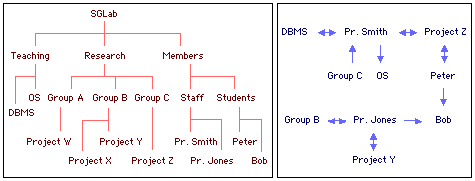 Fig. 1. Hierarchical and network organizations of
the SGLab Web Site.
Fig. 1. Hierarchical and network organizations of
the SGLab Web Site.
2.1. Hierarchical organization of the site
The SGLab Web site provides information about an imaginary computer science
institute. This information can be placed in a hierarchy reflecting aggregation
relationships, as shown in Fig. 1a. When complex information is organized
in a hierarchy, it is easier to explore [13]. By making
choices when moving down the hierarchy, the user restricts the amount of
information considered worth examining. For example, if the user is looking
for Professor Smith, he/she will most probably follow the path: SGLab – Members
– Staff – Pr. Smith, considering only 4 among the 20 nodes of the site.
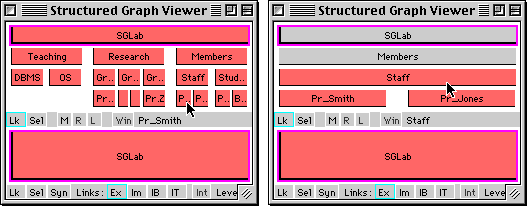 Fig. 2. Overview and context information of the
hierarchy.
Fig. 2. Overview and context information of the
hierarchy.
The upper frame in Fig. 2a and b illustrates how the site hierarchy,
generated on the basis of SGF Metadata sent by the server, is displayed
in SGMapper. The user can click on a node to select it, or shift-click
on a node to zoom in the hierarchy. In Fig. 2b, the user has zoomed on
the Staff node by shift-clicking it and can see only the ancestors and
descendants of this node. These two user operations determine the nature
of the information displayed in a window: in the first case (Fig. 2a),
the user can see an overview of the hierarchy without seeing labels for
every node, while in the second case (Fig. 2b) details for only a portion
of the structure are shown. Both views are useful and it is possible to
switch from one to the other in a single operation. Moreover, the user
can open multiple windows, displaying the hierarchy with different focus
points. When a node is selected, visual feedback is given in all windows.
This helps the user maintain context while getting details. Finally, because
SGMapper is designed to cooperate with a standard Web browser, if the user
double-clicks on a node, the corresponding URL is automatically downloaded
and displayed in the browser.
2.2. Network organization of the site
We have said, the site hierarchy is defined by aggregation relationships.
There is another type of relationship, the associative relationships which
define a network. For example, this is the case when a lab member is associated
with a project, as is Pr. Jones with Project Y. Figure 1b shows the associative
links of the SGLab Web site.
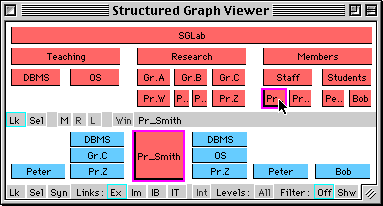 Fig. 3. Network of associative links for the node selected
in the hierarchy.
Fig. 3. Network of associative links for the node selected
in the hierarchy.
Figure 3 shows a portion of the site network reachable from Pr. Smith
displayed in SGMapper. The upper frame represents the hierarchy and the
lower one represents the network. The user has selected Pr. Smith in the
hierarchy frame. Consequently, Pr. Smith appears in the center of the network
frame, where each node has on its left side the associative link sources
and on its right side the associative link destinations. For example, DBMS
is on both the left and right sides of Pr. Smith, because there are two
opposing links joining these nodes. The user can explore the network either
by clicking or shift-clicking a node. The resulting behavior is the same
as in the hierarchy frame, that is either overview or detailed information
of the structure is displayed, or both at the same time if multiple windows
are opened.
2.3. Implicit associative links
Up to now, we have considered two types of links: aggregation links, which
define a hierarchy, and explicit associative links, which define a network.
We now introduce implicit associative links, which are derived from the
hierarchy and the network. Implicit associative links capture relations
between sub-hierarchies. As shown in Fig. 4, there exists an implicit
associative link between the sub-hierarchies P and Q, when there is at
least one explicit associative link between the elements s and d, respectively
in P and Q. Formal definitions are given in Appendix A. An example of an
implicit associative link in the SGLab site is: from Group C to Students,
where P = Group C, Q = Students, s = Project Z and d = Peter.
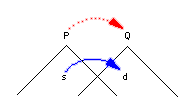 Fig. 4. Implicit associative link.
Fig. 4. Implicit associative link.
SGMapper provides a number of features, which allow users to select
portions of the structure and to determine which explicit/implicit associations
between them are displayed. Space prevents us from describing these functions
in detail. However, we would like to illustrate their ability to answer
simple visual queries. Consider the research groups A, B and C and the
member categories Staff and Students. The user could be interested to find
out, what kind of members are associated with each group. Figure 5a to
c shows, how the user could answer this question with SGMapper. The user
needs to select the Member's sub-hierarchy and to successively click on
each of the three Research groups to see the associations. First, group
A is selected and no association with any member is seen. Second, the user
clicks on group B, as shown in Fig. 5a. There is an (implicit) link between
Group B and Staff, but not between Group B and Students. Third, the user
clicks on Group C, as shown in Fig. 5b. There are (implicit) links between
Group C and Staff, and between Group C and Students. The interpretation
of the three views gives the answer: both students and staff members are
associated with group C, only staff members are associated with group B,
and no one is associated with group A. In Fig. 5c, another function of
the viewer is used to further restrict the displayed associations.
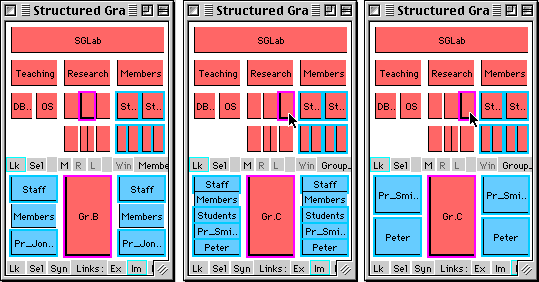 Fig. 5. Implit associative links allow simple
visual queries to be answered.
Fig. 5. Implit associative links allow simple
visual queries to be answered.
2.4. SGLab Web site description with SGF
We have shown, how the structure of a site can be described with hierarchical
and associative links. We now introduce SGF, a format for encoding this
information. Table 1 shows a portion of such a file, describing the example
site:
-
the site structure is captured as a structured graph, defined between
the <STRUCTUREDGRAPH> and the </STRUCTUREDGRAPH>
tags,
-
the set of nodes is defined between the <NODES> and
the </NODES> tags,
-
the set of hierarchical links is defined between the <HIERARCHY>
and </HIERARCHY> tags,
-
the set of associative links is defined between the <NETWORK>
and </NETWORK> tags,
-
each node is defined by NODEID and LABEL attributes,
the URL is defined in an optional <SGATT> sub-element between
<NODE> and </NODE> tags,
-
each link is defined by SOURCE and DEST attributes
matching one of the NODEID attributes, within <LINK>
and </LINK> tags
<!DOCTYPE STRUCTUREDGRAPH SYSTEM "SGF.dtd">
<STRUCTUREDGRAPH>
<NODES>
<NODE NODEID="N001" LABEL="SGLab_Home_Page">
<SGATT NAME="URL" VALUE="http://www.sglab.edu"
/>
</NODE>
<NODE NODEID="N002" LABEL="Teaching">
<SGATT NAME="URL" VALUE="http://www.sglab.edu/teaching.html"
/>
</NODE>
<NODE NODEID="N003" LABEL="Research">
<SGATT NAME="URL" VALUE="http://www.sglab.edu/research.html"
/>
</NODE>
[...]
<NODE NODEID="N016" LABEL="Project_Z">
<SGATT NAME="URL" VALUE="http://www.sglab.edu/projects/project_z.html"
/>
</NODE>
<NODE NODEID="N019" LABEL="Peter">
<SGATT NAME="URL" VALUE="http://www.sglab.edu/~peter"
/>
</NODE>
</NODES>
<HIERARCHY>
<LINK SOURCE="N001" DEST="N002"> </LINK>
[...]
</HIERARCHY>
<NETWORK>
<LINK SOURCE="N019" DEST="N020"> </LINK>
[...]
</NETWORK>
</STRUCTUREDGRAPH> |
Table 1. SGF description of SGLab Web site
3. SGF specification
The previous example has presented a possible way to describe site structure.
We have also shown a partial SGF document. We now present the SGF specification,
in the form of its XML Document Type Description (DTD). As raised in the
introduction, the need for Metadata on the Web is becoming widely recognized,
to make huge quantities of information available not only for human browsing,
but also for machine understanding. Many of the emerging formats use the
eXtensible Markup Language (XML) as a common syntactic layer. An XML document
contains text and nested tags defining elements and attributes. A DTD defines
the constraints for a document class.
Table 2 gives the SGF DTD. Without explaining in detail the syntax of
an XML DTD [c], we describe the SGF validity constraints
with reference to the related XML keywords given in parenthesis:
-
the root of an SGF document must be a STRUCTUREDGRAPH element,
-
a STRUCTUREDGRAPH element can have an arbitrary number of SGATT
sub-elements, followed by a NODES, a HIERARCHY and
a NETWORK sub-element (SGATT*,NODES,HIERARCHY,NETWORK),
-
the NODES element can have an arbitrary number of NODE
elements (NODE*),
-
the HIERARCHY element can have an arbitrary number of LINK
elements (LINK*),
-
the NETWORK element can have an arbitrary number of LINK
elements (LINK*),
-
a NODE element must (#REQUIRED) have a unique identifier
(ID) NODEID attribute,
-
a NODE element can (#IMPLIED) have a LABEL attribute,
-
a NODE element can have an arbitrary number of SGATT
sub-elements (SGATT*),
-
a LINK element must (#REQUIRED) have a SOURCE
attribute, for which there must exist a corresponding unique id attribute
(#IDREF),
-
a LINK element must (#REQUIRED) have a DEST
attribute, for which there must exist a corresponding unique id attribute
(#IDREF),
-
a LINK element can (#IMPLIED) have a LABEL attribute,
-
a LINK element can have an arbitrary number of SGATT
sub-elements (SGATT*),
-
a SGATT element must (#REQUIRED) have two attributes,
NAME and VALUE.
SGATT elements make SGF extensible, allowing the addition of application
specific information. SGMapper, for example, uses SGATT in NODE
elements to store their corresponding URL.
<!-- SGF DTD -->
<!-- a SG is defined by 3 sets: nodes, hierarchical
and associative links -->
<!ELEMENT STRUCTUREDGRAPH (SGATT*,NODES,HIERARCHY,NETWORK)>
<!-- the set of nodes -->
<!ELEMENT NODES (NODE*)>
<!-- the set of hierarchical links -->
<!ELEMENT HIERARCHY (LINK*)>
<!-- the set of associative links -->
<!ELEMENT NETWORK (LINK*)>
<!-- a node -->
<!ELEMENT NODE (SGATT*)>
<!ATTLIST NODE
NODEID ID #REQUIRED
LABEL CDATA #IMPLIED >
<!-- a link between 2 nodes -->
<!ELEMENT LINK (SGATT*)>
<!ATTLIST LINK
SOURCE IDREF #REQUIRED
DEST IDREF #REQUIRED
LABEL CDATA #IMPLIED >
<!-- SGATT allows definition of application specific
attributes -->
<!ELEMENT SGATT EMPTY>
<!ATTLIST SGATT
NAME CDATA #REQUIRED
VALUE CDATA #REQUIRED > |
Table 2. The SGF DTD.
4. Implementation and integration issues
We have shown, how the SGMapper browsing assistant can be used to help
user navigation of a site providing SGF Metadata. We have also explained,
how SGF Metadata is encoded in documents satisfying the validity constraints
dictated by the SGF DTD. We now discuss some implementation issues of SGMapper,
in particular its inter operability with a standard browser. We also explain,
how any Web server can be setup to provide SGF information.
4.1. SGMapper implementation
On the client side, the system allowing a user to navigate Web sites with
SGMapper integrates the following components: a standard Web browser (Netscape
and Microsoft Internet Explorer are supported), a spy program and an interactive
site viewer. The browser is used to access information on the Web in a
completely standard way. The viewer is capable of parsing SGF documents,
of visualizing the structure of the site. The spy provides integration
mechanisms between them. A two-way communication channel and a monitoring
of the browser are needed for the following reasons:
-
when an SGF document is fetched by the browser, it needs to be automatically
forwarded to the viewer,
-
when the user double-clicks on a node in the viewer, the related URL should
be downloaded by the browser,
-
when a user navigates a site with the browser and accesses a page, visual
feedback should be given in the viewer.
Standard Web browsers support some level of inter operability. Both Netscape
[k] and Microsoft Internet Explorer [l]
have defined an client API based the same event suite defined by SpyGlass
[m]. Using platform dependant inter process communication
(Apple Events on MacOS, DDE or OLE on Windows), it is possible to exchange
messages with the browser. The following have been used in the implementation
of the spy program:
-
RegisterViewer is sent by the spy to the browser, to declare its
intention to handle SGF files (according to this, every time a hyperlink
pointing towards a file of SGF MIME type is followed, the file is downloaded
on the client computer and opened by the spy),
-
OpenURL is sent from the spy and starts a download and display
of the specified URL by the browser,
-
RegisterURLEcho is sent by the spy to the browser and causes the
browser to send URLEcho messages to the spy,
-
URLEcho messages are sent to the registered spy every time a URL
is downloaded in the browser, giving the reference of this URL and its
MIME type.
 Fig. 6. Client side integration.
Fig. 6. Client side integration.
The overall behavior of the system is illustrated in Fig. 6: at initialization
time, the spy registers both to be alerted when URLs are fetched by the
browser (1) and to handle SGF files (2). When a HTML resource is downloaded
from the Web (3), the browser alerts the spy (4). When the resource MIME
type is SGF (5), then the browser stores it on disk and sends a request
to the spy to open it (6). The spy can then forward the Metadata to the
Viewer, which can display it (7). When the user double-clicks on a node
in the viewer, this alerts the spy (8), which asks the browser to download
the corresponding URL (9). The resource is finally fetched and displayed
in the browser (10).
At the time of writing, the implementation of this architecture has
been almost completed, though some effort is still needed to achieve full
inter operability between the viewer and the browser. Both the spy and
the viewer have been implemented on MacOS, the former in C++ and the latter
in Java. Communication between the spy and the browser is done via Apple
Events, communication between the spy and the viewer is done over TCP/IP.
The viewer uses Microsoft msxml [15] [n]
XML parser. There should not be any major obstacles in porting the code
to the Windows platform, as only the communication between the spy and
the browser would need to be rewritten, using Windows based IPC (DDE for
example).
4.2. Serving SGF metadata
SGMapper works with any Web server, the only restriction being, that it
serves SGF Metadata. There are two requirements: (1) an SGF document must
exist on the server and must be accessible via at least one hyperlink
and (2) when sending this document to a client, the server must explicitly
specify, that it is an SGF document.
Ideally when a visitor arrives on a site, not necessary via the home
page, he/she should be able to get the Metadata quickly and easily, that is
by having to follow a minimal number of links. One possibility, as shown
in Fig. 7, is to have in every document a link to a unique HTML document
(map.html), that gives access to an SGF document (map.sgf). This indirection
for example allows a traditional site map to be provided together with
some information about the Metadata format and available clients.
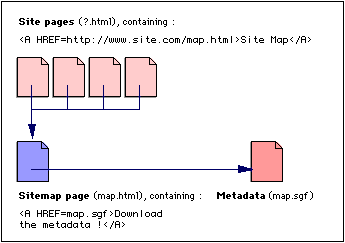 Fig. 7. Giving access to the Metadata on the Web server.
Fig. 7. Giving access to the Metadata on the Web server.
The easiest way to satisfy the second requirement is to rely on MIME
types [o], which are a standard way of determining the
content of a file sent across TCP/IP networks. For this reason, we have
defined a MIME type for SGF files, namely "text/x-sgf". Web servers can
easily be configured to send particular MIME types, generally by adding
a line in a file called "mime.types" or the like, which defines a mapping
between MIME types and a file extensions.
Finally the question of how to build the SGF document capturing the
site structure remains. A straightforward method is to manually encode
the information using a text editor. A more realistic approach would be
to create or adapt a site design tool, such as NetObject Fusion [p],
SiteMill [q] or Front Page [r], which
could automatically generate an SGF description of the site on the basis
of relationships defined by the designer. Another approach would be to
generate the Metadata by parsing the documents of the site. This process
would be easier, if the HTML documents contained some extra information
about the links, as proposed in [8].
5. Conclusion
The motivation for our work is based on our belief, that Metadata describing
the structure of Web sites is useful. For this reason, we have proposed
SGF, which allows the encoding of a site using a Structured Graph. To demonstrate,
we have presented SGMapper, which uses SGF information to improve user
navigation in a site.
Benefits of this system include (1) efficiency, as the structure is downloaded
once, in a single transfer, permitting exploration of the site structure
without sending further requests to the server, (2) help for navigation,
as both context and detail information about a site are given to the user
by multiple windows, and (3) the ability to answer visual queries, taking
advantage of implicit associative links defined by the Structured Graph
formalism.
SGMapper is only one of the possible uses of SGF Metadata. Because SGF
is a public format, any client application could request SGF documents
from a Web servers and process them. Software agents could take advantage
of this, by regularly checking the evolution of the structure of a site
and initiate appropriate actions. For example, think of an agent, which
would notify you every time a new paper is written by your favourite author.
Altogether, SGF illustrates three of the envisioned use of XML: (1) applications
that attempt to distribute a significant proportion of the processing load
from the Web server to the Web client, (2) applications that require the
Web client to present different views of the same data to different users,
and (3) applications in which intelligent Web agents attempt to tailor
information discovery to the needs of individual users.
A first step in our future work is to complete and enhance the integration
of SGMapper with Web browsers. Beyond this, we would like to explore the
use of other capabilities of structured graphs [17],
such as support for links having multiple destinations and sources, link
hierarchies and link types. We have started to implement a robot, which
explores a Web site and generates its SGF structure description using a
set of rules to distinguish between hierarchical and associative links.
We have also started an extension of the system, which would support storing
the user's browsing history in SGF. The associated Structured Graph would
grow dynamically as the user would visit different sites, either by using
SGF Metadata if provided, or by infering the nature of the links with a
similar set of rules used by the robot. Format specification, demonstrations
and progress reports will be published under SGF home page [t].
Acknowledgments
The first author was supported with a Japanese Government Monbusho Scholarship
and the second author by the Japan Society for Promotion of Science with
a fellowship.
Appendix A
This appendix describes a condensed version of structured graphs. Unfortunately
space does not allow definitions for the standard mathematics used here
to be included. However, they can be found in [6].
Definition A.1
A condensed structured graph is the tuple (<=, network) where:
<=: is a finite ordering relation on nodes:
P Node
network: Node -> P Node
Definition A.2
Let G be a condensed structured graph (<=, net). Let the abstraction
operator A map from condensed structured graphs to condensed structured
graphs. Then A(G) = (<=, net') where:
For all p,q: nodes such as
(p,q) in net' if and only if
there exists (s,d) in net such as p <= s
^ p || d ^ q <= d ^
q || s
The abstraction operator takes a whole structured graph and adds implicit
links represented as node pairs to it. The rule for adding an implicit
link can be summarized as: a node p is an implicit link source when it
is above a node s which is an explicit link source and the link destination
d is outside p, see Fig. 5. There is a corresponding requirement for
the link destination.
References
[1] K. Andrews, Browsing, building and beholding cyberspace,
new approaches to the navigation, construction, and visualisation of hypermedia
on the Internet, Doctoral dissertation, Graz University of Technology,
September 1996
[2] J. Bosak, XML, Java, and the future of the Web,
Sun Microsystems, October 1997, available on the Web at http://sunsite.unc.edu/pub/sun-info/standards/xml/why/xmlapps.html
[3] G. Collaud, J. Dill, C.V. Jones and P. Tan, The
continuously zoomed Web — a graphical navigation aid for WWW,
in: Late Breaking
Hot Topic in conjunction with Visualization'96, October 27–November 1,
San Francisco, California, 1996
[4] J. Conklin, Hypertext: an introduction and survey,
IEEE Computer, 20(9): 17–41, 1987.
[5] D.W. Edwards and L. Hardman, Lost in hyperspace:
Cognitive Mapping and Navigation in a Hypertext Environment, Intellect
Books, Oxford, 1989.
[6] B.A. Davey and H.A. Priestley, Introduction to
Lattices and Order, Cambridge University Press, 1990.
[7] G. W. Furnas, Generalized fisheye views, in: CHI'86
Proceedings, Boston, MA, pp. 16–34.
[8] D. Glazman, Navigation through LINK elements
in HTML, 15 June 1997, available on the Web at http://www.w3.org/TR/NOTE-link
[9] K.L. Jones, NIF-T-NAV: a hierarchical navigator
for WWW pages, in: Proc. of the 5th International World Wide Web Conference,
May 1996, Paris, France, available at http://www5conf.inria.fr/fich_html/papers/P39/Overview.html
[10] J. Lamping, R. Rao and P. Pirolli, A focus+context
technique based on hyperbolic geometry for visualizing large hierarchies,
in: Proc. CHI'95, Denver, Colorado, Pub. ACM, pp. 401–408.
[11] D.B. Lowe, A. Ginige, M. Sifer and J. Potter,
The Matilda Data Model and its implications, in: Proc. of the 3rd
International Conference on Multimedia Modeling, Toulouse, November 1996.
[12] J.D. Mackinlay, S. Card and G. Robertson, Perspective
wall: detail and context smoothly integrated, in: Proc. of the ACM
SIGCHI'91 Conference on Human Factors in Computing Systems, New Orleans,
LA, April 1991, pp. 173–179.
[13] S. Mukherjea, J.D. Foley, and S. Hudson,
Visualizing complex hypermedia networks through multiple hierarchies,
in: Proc. of the ACM SIGCHI'95, Denver, Colorado, USA, May 1995, available
at http://www.acm.org/sigchi/chi95/proceedings/papers/sm_bdy.htm
[14] D.A. Nation, C. Plaisant, G. Marchionini, and
A. Komlodi, Visualizing Websites using a hierarchical table of contents
browser: WebTOC, in: Proc. of the 3rd Conference on Human Factors
and the Web, Denver, Colorado, June 1997.
[15] J. Paoli, D. Schach, C. Lovett, A.
Layman, and I. Cseri, Building XML parsers for Microsoft's IE4, World
Wide Web Journal (W3J), II(4), Fall 1997.
[16] M. Sifer and J. Potter, Structured graphs: a
visual formalism for scalable graph based CASE tools, Australian Computer
Journal, 28(1): 13–26, February 1996. Errrata published in
28(2): 71, May 1996.
[17] M. Sifer, Structured graphs: a visual formalism
for scalable graph based tools and its application to software structured
analysis, Ph.D. thesis, University of Technology Sydney, 1996.
URL Section
[a] The World Wide Web Consortium, at http://www.w3.org
[b] Metadata and Resource Description at W3C, at http://www.w3.org/Metadata/
[c] Extensible Markup Language, W3C Working Draft,
at http://www.w3.org/TR/WD-xml-lang
[d] Extensible Markup Language, at http://www.w3.org/XML
[e] Extensible Markup Language, at http://www.sil.org/sgml/xml.html
[f] The XML FAQ, at http://www.ucc.ie/xml/
[g] Channel Definition Format Specification, at http://www.microsoft.com/standards/cdf.htm
[h] Document Object Model Specification, at http://www.w3.org/TR/WD-DOM/
[i] Meta Content Framework with XML Specification,
at http://www.textuality.com/mcf/NOTE-MCF-XML.html
[j] Open Software Description Format Specification,
at http://www.w3.org/TR/NOTE-OSD.html
[k] Netscape Operating System-Specific Client APIs,
at http://home.netscape.com/newsref/std/
[l] Dynamic Data Exchange Support in Microsoft Internet
Explorer, at http://support.microsoft.com/support/kb/articles/Q160/9/57.asp
[m] Spyglass, at http://www.spyglass.com
[n] Microsoft MSXML parsr at http://www.microsoft.com/standards/xml/xmlparse.htm
[o] MIME FAQ, at http://www.cis.ohio-state.edu/hypertext/faq/usenet/mail/mime-faq/top.html
[p] NetObject Fustion, at http://www.netobjects.com/html/products.html
[q] Adobe SiteMill, at http://www.adobe.com/prodindex/pagemill/siteben.html
[r] Microsoft Front Page, at http://www.microsoft.com/frontpage/
[s] Web Collections using XML Submission, at http://www.w3.org/TR/NOTE-XMLsubmit.html
[t] SGF Home Page, at http://www.isl.hiroshima-u.ac.jp/projects/SGF/
Vitae
 Olivier Liechti received his Diploma in Computer Science at the University
of Fribourg, Switzerland in 1995. He has been working for several years
at Prisme Informatique in Switzerland, where he was involved in DBMS and
intranet related projects. He is now a PhD student at the Information System
Laboratory in Hiroshima University, Japan. His main research interests
are in Web technologies, CSCW systems, mobile and ubiquitous computing
environments.
Olivier Liechti received his Diploma in Computer Science at the University
of Fribourg, Switzerland in 1995. He has been working for several years
at Prisme Informatique in Switzerland, where he was involved in DBMS and
intranet related projects. He is now a PhD student at the Information System
Laboratory in Hiroshima University, Japan. His main research interests
are in Web technologies, CSCW systems, mobile and ubiquitous computing
environments.
|
| |
 Mark Sifer is presently a JSPS research fellow with the Faculty
of Engineering at Hiroshima University. Previously he was a Lecturer at
the University of Technology Sydney, where he also completed a PhD. He
has also worked at a range of companies and organisations as a software
developer. His main research interest is in graph abstraction models and
their application to the design of graph based software tools. Mark Sifer is presently a JSPS research fellow with the Faculty
of Engineering at Hiroshima University. Previously he was a Lecturer at
the University of Technology Sydney, where he also completed a PhD. He
has also worked at a range of companies and organisations as a software
developer. His main research interest is in graph abstraction models and
their application to the design of graph based software tools.
|
| |
 Tadao Ichikawa graduated from Waseda University also receiving his
Doctor of Engineering degree from Waseda University. Prior to his professorship
at Hiroshima University, he worked at the Research and Development Laboratory
of Kokudai Denshin Denwa Co., Ltd. (KDD) in Tokyo. He moved to Hiroshima
University in 1979, where he is responsible for research and education
in information and computer sciences as Professor of the Information Systems
Laboratory. He initiated the IEEE Symposium on Visual Languages and the
IEEE International Conference on Multimedia Computing and Systems in 1984
and 1994, respectively. At the IEEE (Institute of Electrical and Electronics
Engineers) Computer Society, he also founded the Technical Committee on
Multimedia Computing and the Task Force on YUFORIC (Youth Forum in Computer
Science and Engineering)in 1992 and 1995, respectively. He is on the editorial
board of the IEEE Transactions on Knowledge and Data Engineering and the
International Journal on Visual Languages and Computing. He currently serves
as Board of Govenors at the IEEE Computer Society. He is an IEEE Fellow. Tadao Ichikawa graduated from Waseda University also receiving his
Doctor of Engineering degree from Waseda University. Prior to his professorship
at Hiroshima University, he worked at the Research and Development Laboratory
of Kokudai Denshin Denwa Co., Ltd. (KDD) in Tokyo. He moved to Hiroshima
University in 1979, where he is responsible for research and education
in information and computer sciences as Professor of the Information Systems
Laboratory. He initiated the IEEE Symposium on Visual Languages and the
IEEE International Conference on Multimedia Computing and Systems in 1984
and 1994, respectively. At the IEEE (Institute of Electrical and Electronics
Engineers) Computer Society, he also founded the Technical Committee on
Multimedia Computing and the Task Force on YUFORIC (Youth Forum in Computer
Science and Engineering)in 1992 and 1995, respectively. He is on the editorial
board of the IEEE Transactions on Knowledge and Data Engineering and the
International Journal on Visual Languages and Computing. He currently serves
as Board of Govenors at the IEEE Computer Society. He is an IEEE Fellow.
|







